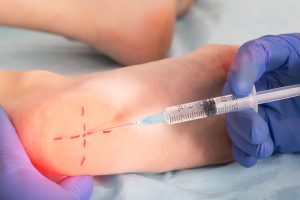Steroid Injections
Ultrasound guided steroid injections are a very common treatment option for painful areas around the body. The foot and ankle take a tremendous amount of pressure from our body weight and can therefore easily develop aches and pains. High impact activities increase these forces which further increase the chances of developing problems.

What is a steroid injection?
Steroid injections are made up of corticosteroid, which is an artificial steroid that helps reduce inflammation. If you inject this next to inflamed tissues, the inflammation and pain should settle.
Foot and ankle issues that benefit from steroid injections:
There are many bony and soft tissue structures that can become affected in the foot. These can include the joints, tendons, plantar fascia (heel pain) and neuromas. All of these can benefit from steroid injections.
How are steroid injections administered?
Local anaesthetic is used to numb the area first and the needle is placed in the location. Accuracy of the needle placement can be improved with the use of ultrasound guidance. Once the needle is in the location and the area is numb the steroid is injected.
Benefits of a steroid injection:
The reduction in inflammation following a steroid injection should reduce the symptoms so the pain should subside. The effects can take time to work but usually within a few days.
How often do you require a steroid injection?
As a general guide, it is advised to not have more than a few injections a year. Some very common conditions that can benefit from an occasional steroid injection include arthritis and gout. With arthritis, any joint in the foot and ankle can become inflamed. With gout, it is usually the big toe joint that is most affected. With these conditions however, prevention is important. So your podiatrist can help you with this.
The use of a boot following a steroid injection:
Soft tissues have a small risk of rupture afterwards. For this reason, any soft tissue injections in the foot are followed by the use of a walking boot for one week. This is to protect and offload the foot and reduce the risk of rupture. Steroid injections work by reducing inflammation in the area.
Frequently asked questions
Injections are not usually too painful. The local anaesthetic given beforehand will sting a little but then after this the area should be numb. When the area is numb it allows the steroid to be injected without any pain.
It will depend on the type of work that you do and where the injection was administered. Physical work may require rest for one week, but desk work is usually fine. Soft tissues need more care afterwards to prevent rupture where you may require a boot for for a week.
Generally your specialist can administer up to 3 corticosteroid injections to the same area each year if required.
